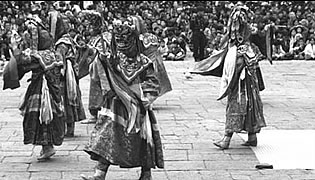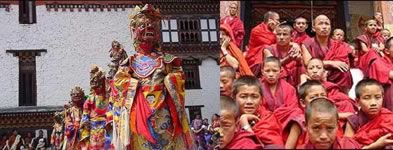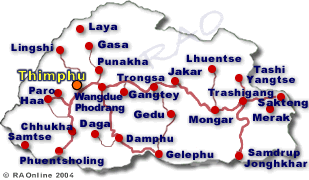 |
|
Festivals
in Bhutan
|
 |
 |
 |
Bhutan
Festivals |
|

|
 |
Bhutan
Festivals |
|
|

|
| Festivities
in the western dzongkhags: Tshechu Festivals |
| Thimphu
Lhamoi Drubchhen & Festivals |
 |
Lhamtsom dance one of the highlights of the Lhamoi Drubchhen
| His
Holiness the Je Khenpo is leading 250 monks in the annual Lhamoi
Drubchhen ceremony which began at 2.00 am on August 31 in the Dukhang (assembly
hall) of Tashichhodzong. Lhamtsom dance one of the highlights of
the Lhamoi Drubchhen to be performed on September 12. The sacred
11-day ceremony, dedicated to the protecting deity Pelden Lhamo (goddess
Mahakali), begins in the evenings and continues for 22 hours at a stretch
in a day with short breaks for meals and rest. |
|
The
Drubchhen
was instituted between 1705 and 1709 by Kuenga Gyaltshen, the first
reincarnation of Jampel Dorji, the son of Shabdrung Ngawang Namgyal. According
to legend, Pelden Lhamo appeared before him and performed the dances while
he was in meditation. Based on these dances, Kuenga Gyeltshen initiated
the Drubchhen. Palden Lhamo is the only female dharma protector common
to all four schools of Buddhism and one of the three main protecting deities
of Bhutan.
| The
Drubchhen concludes on September 9 with the Torbuel and Serda ceremony
in the early hours of morning followed by the Lham Tsomo dance,
dedicated to Mahakali, which will be performed in the courtyard of Tashichhodzong
on September 12. The annual
Thimphu tshechu begins on September
15, two days after the conclusion of the Lhamoi Drubchhen ceremony. |
 |
The
annual Thimphu tshechu which was introduced in 1687 during the reign
of the fourth Desi, Tenzin Rabgye, lasts for fours days during which mask
and historical folk dances are performed in the courtyard of the Tashichhodzong.
Meanwhile,
the Gonpoi Drubchhens are being performed in Rinpung dzong in
Paro and Wangduephodrang dzong. The Gonpoi Drubchhen is dedicated to
Yeshey Goenpo or Mahakala, the main protecting deity of Bhutan. The Gonpoi
Dubchhen was introduced in Paro, Wangduephodrang and Trongsa by the
68th Je Khenpo, His Holiness Tenzin Dendup, in 1987. Yeshey Goenpo is one
of the most prominent guardians or protector deities of the Drukpa Kagyue
school of Buddhism. An emanation of Chenrezi (Avalokitesvara), Mahakala
is the wrathful deity that destroys mind chatter and brings the mind back
into attentive focus.
Meanwhile,
an eight-day Peling Drubchhen at Gangtey Goenpa in Wangduephodrang
concludes tomorrow with the Nguedup Langwa (receiving of spiritual wisdom/power)
in the morning. The Drubchhen is being performed by the Sungtrul Rinpoche
and the Gangtey Trulku in connection with the reconstruction of the 451-year
old Gangtey Lhakhang.
The
annual three-day Gangtey Tshechu will begin on September 14. On
September 17 the public can receive blessings from the sacred images of
the Lhakhang which will be shifted to a safer place in preparation for
the lhakhang(s reconstruction.
 |
Several
thousand devotees are attending the Thimphu Tshechu which will conclude
today with the dance of the eight manifestations of Guru Rinpoche (Guru
Tshen Gyed) where dancers depict the eight forms of the Guru.
The
four-day annual Thimphu Tshechu, which began on September 26, was preceded
by the 15-day Lhamo Dubchhen, a rite performed to appease the protecting
deity Pelden Lhamo (goddess Mahakali). |
The
main highlight of the 15-day annual Dubchhen was the LhamTsomo dance, dedicated
to Mahakali, performed in the courtyard of Tashichhodzong on Sunday. The
Dubchhen was instituted sometime between 1705 and 1709 by Kuenga Gyaltshen,
the first reincarnation of Jampel Dorji, the son of Zhabdrung Ngawang Namgyal.
According to legend, Pelden Lhamo appeared before him and performed the
dances while he was inmeditation. Based on these dances, Kuenga Gyeltshen
initiated the Dubchhen. Palden Lhamo is the only female dharma protector
common to allthe four schools of Buddhism. She appears very wrathful,
and ridesher mule through a sea of blood, surrounded by fire.
The
Thimphu tshechu was introduced in 1687 during the reign of the fourth Desi,
Tenzin Rabgye.
Meanwhile,
the annual Phurpai Dubchhen (Vajra tradition) ceremony at the National
Memorial Chorten concluded on September 27 with the Nguedup Langwa blessings.
The eight-day ceremony was performed in three groups.
According
to a spokesman for the Dratshang Lhentshog, the Phurpai Dubchhen was started
in 1974 as part of completion ceremony for the National Memorial Chorten
and became an annual ceremony in 1981.
|





